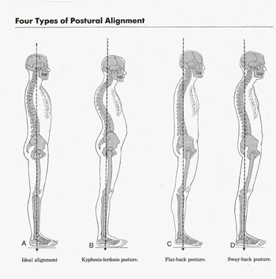Newsletter August 2013
General Wellbeing - Good posture vs. Bad posture...
This month, I'll be returning to one of my favourite topics - looking at posture and what it means. We've all probably heard or been told that we either have good or bad posture, however, what does this actually mean and what can we do to make our posture better?
Generally speaking, there are 4 different postural types (shown in diagram). These are:
- Ideal
- Kyphotic / Lordotic
- Flat back
- Sway back

In short, anything other than have a posture approaching the 'ideal' will cause stresses and strains on the core muscles and your spine. It is these additional pressures that can increase the risk of developing pain and back problems. However, it is not to say that someone who has an 'ideal' posture will never get a bad back, it is just less likely!
Another aspect of posture that is often overlooked is your seated posture, in a world where a majority of people work long hours sat in offices, this is something that is becoming increasingly important.
Postural imbalance can be caused by a number of things so it is always important to see a qualified practitioner as part of trying to make any adjustments. However, there are some little things you can do to help yourself:
- Stretch out your chest muscles, this will help to relieve any mid-back pain caused by sitting at a desk, or computer
- When walking, clench your buttock muscles to ease low back pain
- When driving, make sure your low back is pressed into the seat, so that when you use the pedals you do not have to twist your body
- When seated at a desk, use a wedge cushion to raise your hips higher than your knees, this will help you sit up straighter.
- If your job requires you to sit down for most of the day, make sure you take regular (every 20-30mins) breaks to get up and move around for just a few minutes.
